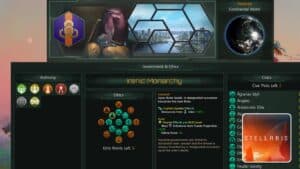Knowing how to manage and run an effective economy is what separates average players from great players in Stellaris. You can create a vast fleet whose power could destroy the greatest of galactic threats. But if you can’t afford the costs to run those ships, they are no better than scrap.
There are 16 currencies, or resources, in Stellaris. This can, of course, seem daunting, but this guide will explain all you need to know to manage that. A lot of those currencies don’t even become relevant until later on in the game, anyway, and some may never become available.
Recommended Read: What to Do With Primitives in Stellaris
Once you learn about the economy from this guide, you will be well-equipped to take any empire, from space explorers to a galactic powerhouse. Always remember, if your empire can’t sustain itself, it will crumble to dust before your eyes.
This Stellaris economy guide will cover; how the economy works, all the resources in the game, how to collect resources, resource storage, how to build a strong economy, how to keep an economy thriving, using megastructures for economy growth, and traditions.
Table of Contents
How Does the Economy Work in Stellaris?
All resources in Stellaris work on a production and consumption system. Everything in the game, whether that be a single building or a pop; will both produce something and consume something.
The things that get consumed, or produced, come in two varieties. They are either material resources; things that exist. Or they are abstract assets; such as galactic influence or fleet power.
Ensuring that what you produce is more than you consume is the secret ingredient to a strong economy.
During gameplay, at the top of the screen, you will see a very useful and easy-to-translate guide to your economy.
It will display the amount of resources you have right now for every resource and a plus or minus of the predicted monthly change.
If you can keep all of those resources on a plus and not a minus, you are pretty much there in the mastery of the economy. Of course, that is a gross oversimplification, but it is not inaccurate either.
You can get a more detailed background of a resource’s expenditure and production by highlighting the resource at the top of the screen. The game will display a detailed tooltip of everything you could ever want to know.
Before you can work on increasing your resource production, you will have to know what all the resources are for.
Resources
The primary way to produce resources for your economy is through the use of pops.
If it can, a pop will take on a job and begin producing resources for your empire. This is not the only method of production, but it is the highest producer.
Mining stations, and other assets, exist only to supplement the output of your pops.
As I mentioned before, resources come in two varieties; physical and abstract. The next section will provide a brief description of every resource in the game.
Material Resources
These resources pay for your empire. Almost anything you will construct in Stellaris will make use of at least one material resource.
The material resources come in four separate varieties. These varieties are basic resources, advanced resources, strategic resources, and special resources.
Basic Resources
These are the bedrock of any empire’s infrastructure. They come from jobs in resource districts and mining stations.
- Energy Credits. The galaxies’ true currency. Used for buying other resources and upkeep of almost everything you will ever make. Robotic pops need this for pop upkeep.
- Minerals. The bedrock of all industry in Stellaris. If you want to build anything, it will involve using minerals in some way. Lithoid pops use minerals as food.
- Food. If your pops are biological, you will need food to ensure they survive. No food means no pops. No pops means no resources.
Advanced Resources
There are two kinds of advanced resources, and they are both created from minerals.
You can find deposits for mining stations, but these are rare and should not be relied upon. Pops make these resources through industrial districts or from specialist job buildings.

- Alloys. Your fleets and, ergo, your military, live and die by your alloy production. If you plan on using megastructures, which you should, you will need to pay a large quantity of alloys to get them.
- Consumer Goods. A resource needed for pop upkeep costs. Specialist jobs, such as research or politicians, use consumer goods as upkeep too.
Strategic Resources
There are three strategic resources. Their primary function is to allow owners to construct and maintain advanced technology.
Advanced ship components, advanced structures, and advanced edicts; all make use of these strategic resources. The strategic resources are:
- Exotic Gases.
- Rare Crystals.
- Volatile Motes.
Special Resources
Now, special resources are like strategic resources, except with one major difference. No standard empire can fabricate these resources for themselves.
The only way to get these resources is by finding a source in space and building a mining station. The four special resources are:
- Zro.
- Dark Matter.
- Living Metal.
- Nanites.
If strategic resources unlock advanced ship components, special resources unlock the super components.
The most advanced components in the game need these resources. You won’t gain access to all of these during a game. So concentrate only on the ones you find and forget about the others.
Resource Storage
Material resources are stockpiled up to your empire’s limit. The default limit is 15,000 for all resources except energy, which is 50,000.
You can increase this cap by; building resource silo’s, forming the galactic market, and researching the mega-engineering tech. If you are at your cap and produce more resources, you lose those extra resources.
The abstract resources in the next section have no cap. Except for influence, which has a hard cap of 1000 which can never change.
Abstract Resources
Unlike material resources, which have a physical presence. Abstract resources represent your empire’s knowledge, sway in the galaxy, and technology power.

There are four abstract resources:
- Research. Created from research jobs and research stations. Whenever this “currency” is gained, it is instantly spent on your research projects. The higher your research production, the faster your research speed. If you have no current projects, it gets stored for later use.
- Trade value. This is a number assigned to the economic activity within your empire. Depending on your Trade Value policy, your empire will produce extra energy, unity, or consumer goods.
- Unity. A representation of your societies’ shared values and strength. Unity is how you buy edicts, leaders, and the all-important traditions.
- Influence. A unique resource in Stellaris in a number of different ways. Influence production remains quite static in most games. It represents an empire’s power to make others recognize your actions as truth. Expanding borders, making claims, changing vassal contracts, and other things that require making another empire agree with you all need influence.
How to Build a Strong Economy
Now that you have a basic understanding of what all the resources are for; you are well-equipped to start building a strong economy.
Building an economy starts as a busy journey; there’s a lot to manage, and you will be reacting to changes regularly. This difficult journey, with any luck, will culminate in a set-it-and-forget-it stance.
The aim is to do all the hard work early so that when the end game comes around, your economy is so powerful you don’t need to worry about it too much.
The end game of Stellaris is hard. You will have way too much on your plate to be worrying about energy production in one of your frontier sectors.
Due to the procedural generation of maps in Stellaris, I cannot give you a step-by-step guide to creating the perfect economy. What I can give you is some tenets that, if you stick to them, will yield you some fantastic results.
Building a Strong Foundation
Building a strong economy in Stellaris all starts with a strong foundation.
That foundation relies upon one golden rule; “produce more resources than you spend.” Keep your monthly changes numbers in the positive, and you will not be far from wrong.
I know it sounds obvious, and is much easier said than done. But trust me, as long as every economic decision you make has those six simple words in mind; your end result will be a strong economy.
With that bit out of the way, I have five core tenets to teach that will help make achieving the golden rule a piece of cake.
- You need more pops. Resources from pop jobs fuel early-game economies. The more pops you have, the more jobs those pops can be doing. The more jobs that are being done, the more resources your empire produces. Take steps to increase your population; early and often.
- Not all material resources are equal. Some resources are more valuable than others and, as such, should be higher on your priority list. This can depend on a lot of factors. The main one is the kind of empire you are playing. A good priority list for most empires would be Energy>Minerals>Alloys>Consumer Goods>Strategic Resources>Food>Special Resources.
- Research economy bonuses. Is there anything research can’t do in Stellaris? The answer is no, by the way. Which is why research is king. There are research projects in Stellaris that provide percentage bonuses to resource production to your empire. You should prioritize these projects almost always. New weapons and ships are great, but they are useless if you can’t afford to build them.
- Be prepared to react. You are not a machine. You can’t keep a running total of all the maths the game is doing about your economy. As such, you are going to make mistakes and or neglect a resource.
If you notice a resource goes into the negative, don’t panic. Make a plan and get that resource back in the right direction.
- Don’t overextend your production. An economy needs pops to run. It may be tempting to build as much as you can when you first colonize a new world. Then wait for the pops to fill the jobs as they become available.
You shouldn’t do this. Those empty jobs still need upkeep. That upkeep is a waste of good resources.
How to Keep your Economy Thriving
Think of your economy like a building. The golden rule is your building’s foundation. The five tenants are your walls. Then the final stage is a roof to finish the project.
There are three end-game goals that will all but complete your economy.
- Megastructures. The galactic wonders megastructures in particular. The resource bonuses these behemoths produce are too good to ignore. Best of all, these meteoric buffs require zero pops to produce.
- Specialist planets. Most planets have unique features that provide buffs to specific jobs. Making use of these bonuses can be a real difference maker. Devoting a planet only to energy production or research; not only improves output but makes your empire easier to manage as well.
- Get the best traditions and perks. Traditions and ascension perks are free bonuses to your empire. When building a strong economy, you will want prosperity and domination tradition. Mercantile, too, if you can fit it into your build. For perks, you want technological ascendency, galactic wonders, and arcology project. If you plan to take an ascension path, cybernetic or synthetic are the best for economies.
Keeping with the building metaphor, once you finish these goals, your “building” will be complete and will only need basic maintenance to ensure its longevity.
This is everything you need to know about the economy in Stellaris.
If you have any suggestions or questions for this guide, please let us know in the comments section below. As always, have fun building a great economy in Stellaris




